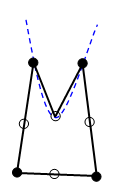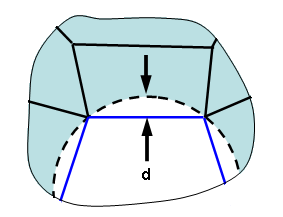When the Options button is pressed on the Model Mesh Settings screen and the Surface icon is selected, a screen with two tabs will appear. The Surface icon will be present regardless of which radio button is selected in the Mesh type section of the Model Mesh Settings screen.
Control the mesh size
The Size field in the Mesh size section of the General tab can be used to specify the size of the elements that will be generated.
- If the Percent of automatic option is selected in the Type drop-down box, you will be defining a percentage of the default mesh size. The slider in this section can be used to control the mesh size. The default mesh size will be calculated based on the dimensions of the model or part.
- If the Absolute mesh size option is selected in the Type drop-down box, you will be specifying the approximate length of the sides of the elements created on the surface of the part.
- The absolute mesh size that corresponds to the percent of automatic is known only when the Use automatic geometry-based mesh size function (located on the Mesh
 Mesh
Mesh 3D Mesh Settings
3D Mesh Settings Options
Options Model dialog) is not activated. In this situation, switching from Percent of automatic to Absolute mesh size will show the mesh size that corresponds to the percent setting, and the slider is shown but disabled.
Model dialog) is not activated. In this situation, switching from Percent of automatic to Absolute mesh size will show the mesh size that corresponds to the percent setting, and the slider is shown but disabled. - When the Use automatic geometry-based mesh size function is activated, switching from Percent of automatic to Absolute mesh size will show a mesh size of 1 regardless of the percent setting, and the slider is not shown.
- When the control Use automatic geometry-based mesh size function (located on the Mesh
 Mesh
Mesh 3D Mesh Settings
3D Mesh Settings Options
Options Model dialog) is activated and the mesh size is set to Percent of automatic, the size of the mesh is different in each part and is based on the size of the part, and so on. When the Use automatic geometry-based mesh size function is not activated and the mesh size is set to Percent of automatic, the size of the mesh is the same in each part and is based on the size of the model.
Model dialog) is activated and the mesh size is set to Percent of automatic, the size of the mesh is different in each part and is based on the size of the part, and so on. When the Use automatic geometry-based mesh size function is not activated and the mesh size is set to Percent of automatic, the size of the mesh is the same in each part and is based on the size of the model.
For advice on specifying an adequate mesh size, go to Mesh Size Hints.
Control meshing retries
If a valid surface mesh cannot be created with the specified mesh size, the meshing algorithm will reduce the mesh size and attempt to mesh the model again. It will repeat this process until either a valid surface mesh is created or it performs the number of retries specified in the Number of retries field in the Retries section of the General tab. On the last retry, the mesher will complete the entire mesh except for the surfaces that it could not mesh correctly. The default value for this field is 6.
Each time a retry is performed, the mesh size is reduced by the factor specified in the Retry reduction factor field. In addition to reducing the mesh size, the following changes are tried (provided these changes result in a mesh that is smaller than the current settings:)
- If the Use automatic geometry-based mesh size function (located on the Mesh
 Mesh
Mesh 3D Mesh Settings
3D Mesh Settings Options
Options Model dialog) is activated, then the first attempt uses the default mesh size times the Retry reduction factor. The default mesh size is defined as the mesh size of 100% without using the Use automatic geometry-based mesh size function.
Model dialog) is activated, then the first attempt uses the default mesh size times the Retry reduction factor. The default mesh size is defined as the mesh size of 100% without using the Use automatic geometry-based mesh size function. - Retry 1: Curvature of edge curve set to 45 degrees
- Retry 2: Minimum adjacent surface curvature set to 30 degrees
- Retry 3: Maximum adjacent surface curvature set to 30 degrees
- Retry 4: Minimum adjacent surface curvature set to 30 degrees and activate Limit adjacent mesh size
- Retry 5: Maximum adjacent surface curvature set to 30 degrees and activate Limit adjacent mesh size
See Controlling the Number of Elements Along Curved Edges below for a description of each of these parameters.
Control the shape of elements with midside nodes
If midside nodes are going to be used in the model (or the part), then use the Generate 2nd order elements on the General tab to control how the midside nodes are created. If this option is not activated, the midside nodes are created at the midpoint between the two corner nodes (see figure (a)). Thus, all sides of the elements are straight regardless of the CAD geometry. If this option is activated, the midside nodes are created on the surface of the CAD (see figure (b)), so the edge of the element is a quadratic and produces a better representation of the surface. However, if the mesh is coarse relative to the radius of curvature, it is possible to produce a highly distorted element if this option is used (see figure (c)). In such cases, the midside nodes on the distorted element are changed to create a straight, undistorted element. Thus, you may see some elements that apparently do not follow the surface of the CAD model even though the option is used. If it is important for these distorted elements to follow the surface, use one of the options for refinement (refinement point, edge curve refinement, and so on.) to get a smaller mesh on the highly curved surfaces.

(a) Without the option, midside nodes do not follow the CAD surface. They are located at the midpoint between the corners of the element.

(b) With the option, midside nodes follow the CAD surface. This results in a more accurate representation of the geometry.

(c) If the mesh size is coarse compared to the curvature, a distorted element can occur. The mesher will make this element straight to avoid the distortion.
 Mesh
Mesh 3D Mesh Settings
3D Mesh Settings Options
Options Model dialog) is not activated. Otherwise, the following controls are disabled.
Model dialog) is not activated. Otherwise, the following controls are disabled. Control the number of elements along curved features
The value in the Feature curve splitting angle field in the Options tab will control how many elements are generated along curves in the feature lines. A smaller value will results in more elements created along the curves.
Control the number of elements along curved edges
The value in the Angle (1-90 degrees) field in the Edge curve refinement section of the Options tab will control how the elements are created along curved surfaces. How this value is used will be determined by the option selected in the Mode drop-down box. If the None option is selected, no refinement will be performed on the curved surfaces of the selected parts. If the Curvature of edge curve option is selected, the specified angle will be used as the average angle between the elements created on curved surfaces. If the Minimum adjacent surface curvature option is selected, the specified angle will be used as the minimum angle between 2 adjacent elements on curved surfaces. This option will usually create fewer elements along the curved edges. If the Maximum adjacent surface curvature option is selected, the specified angle will be used as the maximum angle between 2 adjacent elements on curved surfaces. This option will usually create more elements along the curved surfaces.
If the option Limit adjacent mesh size is activated, then two additional controls on the mesh size are imposed for mesh lines along features of the solid model. (The mesh lines on the interior of the surface are not controlled by this option, but they are controlled by the other options.) The additional controls are as follows:
- The ratio of the mesh size for two adjacent elements is less than the user-entered value. Acceptable values are between 1 (all edge lines the same length) and 10 (rapid growth). See figure (a).
- The deviation of the mesh line from the theoretical curved edge is limited. In some situations, this feature will create more elements than would be implied by the Angle for the Edge curve refinement. See figure (b).

(a) The feature line through the thickness of the part (h1, arrowed) creates the smallest mesh size in this portion of the model. The adjacent mesh lines along the features (blue lines) grow geometrically so that each element is a maximum of X times larger than the previous. For example, if the user-entered a value of 1.3, then h2/h1<=1.3, h3/h2<=1.3, and so on.

(b) The mesh around a hole deviates from the true surface by some distance d. (The lines on the features of the part are shown in blue; the theoretical hole is shown as a dashed circle.) If the deviation with the specified mesh size and other parameters is larger than allowed by the option, the mesh size will be reduced along the feature, thereby reducing the deviation.
Control when quadrilateral elements split
The Fold angle is greater than field in the Spitting quadrangles into triangles section of the Options tab determines which quadrilateral elements are divided into triangular elements based on the minimum fold angle (warp angle) of the quadrilateral. If the minimum fold angle of a quadrilateral element is greater than the value specified in this field, it will be divided into two triangular elements. The fold angle of a quadrilateral is the difference between the planar normals of the two triangles that form the quadrilateral. A flat quadrilateral has a fold angle of zero. The Node angle is greater than field in the Spitting quadrangles into triangles section of the Options tab determines which quadrilateral elements are divided into triangular elements based on the internal node angles of the quadrilateral element. If the node angle is greater than the value specified in this field, it will be split into two triangular elements by adding a line through the vertex of the lines that create the greatest node angle in the element.